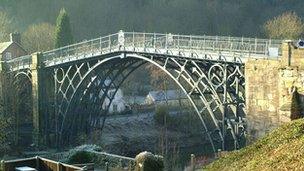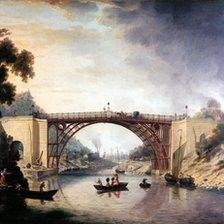Iron Bridge 'may have been scrapped'
- Published

The bridge had suffered structurally due to land movement in the valley
It is seen as the birthplace of the Industrial Revolution but what might surprise many is its most iconic structure was nearly sold for scrap in the 1960s.
In 1986 representatives from more than 50 countries attended a meeting to decide which sites around the world deserved to be protected for future generations.
Among those being considered was Ironbridge Gorge, a small area in rural Shropshire that had once been a hive of industrial and engineering innovation.
The United Nations Educational, Scientific and Cultural Organisation (Unesco) held its 10th session between 24 and 28 November 1986.
By the end of the convention Ironbridge Gorge, site of the world's first iron bridge, had been declared a World Heritage Site.
In 1779 the site saw the use of pioneering technology when a bridge was constructed which made the first structural use of cast iron.
The Iron Bridge was at the heart of a site of coal mining, clay production and manufacture.
Pedestrian toll bridge
But just 40 years earlier the authority responsible for the bridge had started to clear a site for a new bridge so the old one could be knocked down.
Paul Gossage, spokesman for Ironbridge Gorge Museum Trust, said: "It was going to be sold for scrap at one point.
"It was first talked about in the 1940s and in the late 60s and early 1970s it began to rear its head again."
The idea was put forward because it had suffered structurally due to land movement of the valley it was built in.
David de Haan, program director for Ironbridge Institute, said before 1950 the bridge had been owned privately and operated as a pedestrian toll bridge. Motorised transport was prohibited from crossing the bridge in 1934 because of the structural wear and tear.
The then Shropshire County Council was responsible for all bridges in the county, including the Iron Bridge.
"The council was going to pull it down because they realised it was past its sell by date," Mr de Haan said.
"They bought some land and were going to build a new bridge.
"They demolished some buildings in 1946 and were going to knock down the toll house, then in 1971 there were moves to secure the bridge."
He said part of the impetus to protect the bridge could have come about because of the rise of industrial archaeology.
Euston Arch, in London, was considered the first great monument of the railway age but it was demolished in the 1960s amid widespread protest.
After it was knocked down efforts were made to protect those buildings that were important to the UK's industrial heritage.
In 1967 the Ironbridge Gorge Museum Trust was set up to preserve the remains of the Industrial Revolution in the six square miles of the Ironbridge Gorge.
The trust managed to raise thousands of pounds to preserve the bridge.
Mr de Haan said: "The council had set aside £20,000 to demolish the bridge but agreed it could go towards its protection.
.jpg)
The trust managed to raise thousands of pounds to preserve the bridge
"Other funds came from the new body which later became English Heritage and the museum trust, which was very young, raised about a third of all the cost."
In total £147,000 was spent on repairing the bridge, re-enforcing it and resurfacing it.
The work was carried out from 1972 to 1975.
"The amount that was spent doesn't sound like a lot now but it's a couple of million pounds in today's money," he said.
Today the bridge is a tourist attraction and a popular site for school trips. But the appeal of the bridge is nothing new.
Mr de Haan said: "People came to marvel at the iron structure when it was being built. There were well-dressed tourists in the 1780s and it was only in the early 1900s that the area began to decline.
'Sorry state'
"It doesn't make any sense now (to knock the bridge down) but at the time the place was run down and you couldn't sell your house if you lived in Ironbridge.

Well-dressed tourists visited the bridge in the 1780s
"The industry had almost all closed and it was in a really sorry state."
But the area bounced back and more than 550,000 visitors now come to the 10 Ironbridge Gorge museums every year from all over the world.
Next year the site is likely to be back in the spotlight again as it has been designated part of the Cultural Olympiad for the London 2012 Games.
The Olympic flame will be carried over the bridge and a number of art events are scheduled to take place.
The events are likely to bring yet more money into Shropshire's economy through tourism.
But the bridge has always made money, according to Mr de Haan.
"It's always paid its way. When it was a private toll bridge it made money until the end of its toll life," he said.
"Now it is a tourist attraction so it is making money in different ways. It's wonderful."
- Published21 September 2011
- Published12 June 2010